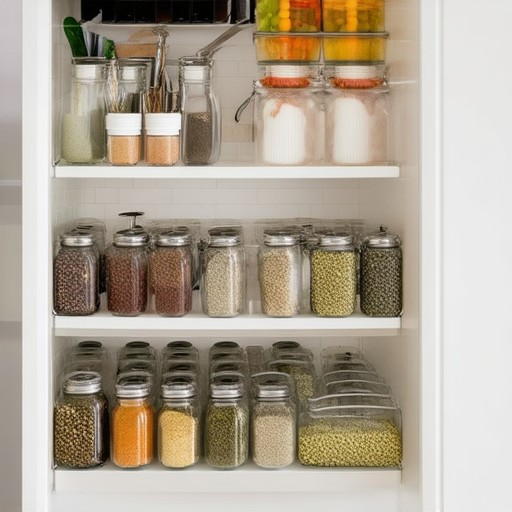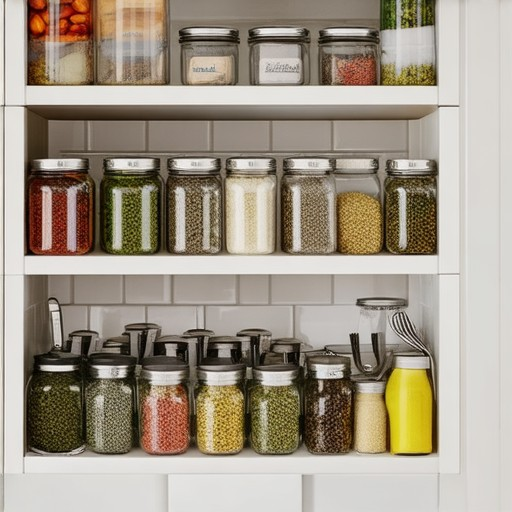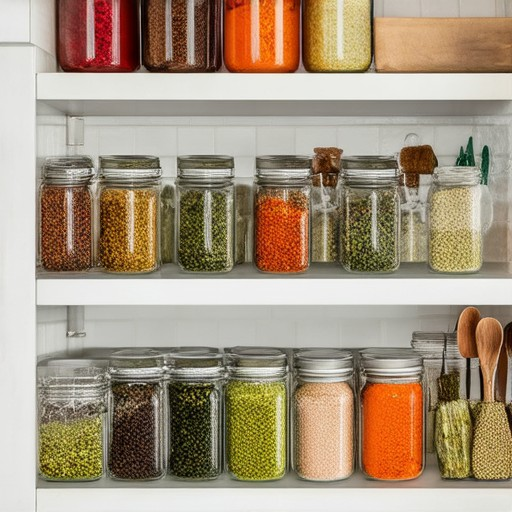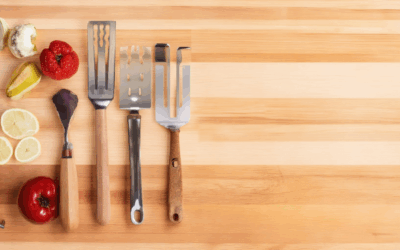Having a well-stocked pantry and kitchen is essential for streamlining daily life, but finding the right essentials without overspending can feel overwhelming. Whether you’re setting up a new home, organizing a small space, or looking to refresh your current setup, affordable kitchen essentials offer a practical solution. From versatile tools to indispensable appliances, these items are designed to enhance efficiency while fitting neatly within any budget. Discover how a thoughtfully curated collection of kitchen essentials can transform your cooking experience, save time, and reduce waste, all while staying within financial reach. This guide explores the must-have items, budget-friendly finds, and smart storage solutions to help you create a kitchen that works as hard as you do.

Minimum Kitchen Essentials
The bare minimum for a functional kitchen includes essential tools that allow you to cook, prepare food, and store items efficiently. Here’s a curated list of the most indispensable items:
- Kitchen Tools:
- Frying pan
- Oven-safe saucepan
- Large, heavy oven-safe pot
- Small pot
- Chef’s knife
- Pairing knife
- Large cutting board
- Small cutting board
- Stackable metal bowls
- Microplane grater
- Mortar and pestle
- Medium whisk
- Ladle
- Steel spatula
- Silicone spatula
- Pair of cooking chopsticks
- Storage & Preparation:
- Measuring cups and spoons
- Large mixing bowl
- Small mixing bowls
- Airtight storage containers
- Vegetable peeler
- Rolling pin
- Pizza cutter
- Measuring tape
- Cooking Aids:
- Baking sheet
- Cooling rack
- Colander
- Sharpener for knives
Must-Buy Kitchen Items
A well-equipped kitchen starts with these essential tools:
- Quality Chef Knife
- Cutting Board
- Mixing Bowls
- Serving Platters
- Measuring Cups & Spoons
- Wooden Spoons & Whisks
- Spatula
- Ladle
- Set of Mixing Spoons

What are the Kitchen Essentials?
An organized kitchen is crucial for efficient cooking and meal preparation. Here’s a list of essential items every kitchen should have:
- Kitchen Knives: A set of high-quality knives is indispensable. Include a chef’s knife, paring knife, and serrated knife.
- Cutting Board: A sturdy cutting board for chopping vegetables and fruits. Choose one large enough for prep work.
- Pots and Pans: Essential cookware includes a saucepan, sauté pan, stockpot, and skillet. Opt for durable materials like stainless steel or non-stick coatings.
- Measuring Cups and Spoons: Accurate measurements are key. Include a variety of sizes for liquids and solids.
- Mixing Bowls: Durable mixing bowls in different sizes for tasks like whisking, blending, or storing leftovers.
- Storage Containers: Airtight containers for keeping ingredients fresh. Sizes ranging from small to large for dry goods and leftovers.
- Utensils: Essential tools like spatulas, ladles, tongs, and whisks. Stainless steel or silicone options are great for heat resistance.
- Cookware Accessories: Items like lids, oven mitts, and dish towels are practical additions for daily use.
- Garlic Press and Herb Grinder: These tools simplify meal preparation by mincing garlic and grinding herbs efficiently.
- Baking Sheets and Trays: Used for roasting, baking, and cooling baked goods. Aluminum foil-lined sheets are a convenient option.
- Blender or Food Processor: Useful for making smoothies, sauces, or doughs. A powerful model ensures versatility.
- Water Bottles and Measuring Glasses: Staying hydrated is essential. A good water bottle and measuring glass for precise pours.
- Cleaning Supplies: Microfiber cloths, sponges, and dish soap are must-haves for maintaining kitchen cleanliness.
- Food Storage Containers: Airtight containers help keep pantry items fresh and organized. Consider labeled ones for easy identification.
- Grill Accessories: If grilling frequently, having a brush, skewers, and cleaning tools makes maintenance easier.
- Small Appliance Hubs: Include a coffee grinder, toaster, or slow cooker depending on your cooking habits.
- Lighting and Ventilation: Proper lighting and ventilation tools like a ceiling fan or portable air purifier enhance the cooking environment.
These items form the backbone of a functional kitchen, enabling efficient preparation and storage solutions. Whether you’re a casual cook or a culinary enthusiast, having the right essentials streamlines your workflow.

What is Needed in a Fully Stocked Kitchen?
- Cooking Tools: Essential knives, pots, pans, baking sheets, and utensils like spatulas and tongs.
- Basic Ingredients: Flour, sugar, salt, pepper, oil, and vinegar.
- Spices and Herbs: A variety of dried and fresh spices, herbs, and seasonings.
- Pantry Staples: Canned goods, pasta, rice, beans, and other non-perishable items.
- Proteins: Chicken, beef, fish, eggs, and tofu for versatile meal preparation.
- Baking Essentials: Yeast, butter, milk, and chocolate for baking needs.
- Fresh Ingredients: Fruits, vegetables, garlic, and onions for daily use.
- Appliances: Microwave, oven, stove, refrigerator, and dishwasher.
- Disposables: Paper towels, aluminum foil, and storage containers.
- Cleaning Supplies: Sponges, dish soap, and trash bags.
- Preparation Tools: Cutting boards, measuring cups, and mixing bowls.
What Should Every Pantry Have?
- Food Staples:
- Flour
- Sugar
- Salt
- Pepper
- Oil (vegetable, olive)
- Baking powder
- Baking soda
- Vanilla extract
- Chocolate chips
- Dry Goods:
- Rice
- Pasta
- Beans (black, chickpeas)
- Oats
- Canned goods (tomatoes, chicken broth, tuna)
- Granola bars
- Nuts (almonds, peanuts)
- Fridge Basics:
- Milk
- Eggs
- Cheese (cheddar, mozzarella)
- Yogurt
- Onions
- Garlic
- Apples
- Spinach
- Bacon
- Ground beef
- Spices & Herbs:
- Cinnamon
- Cumin
- Paprika
- Oregano
- Thyme
- Rosemary
- Basil
- Cleaning Supplies:
- Paper towels
- Sponges
- Dish soap
- Microfiber cloths
- Electronics:
- Calculator
- Measuring cups and spoons
- Blender
- Kitchen scale
- Disposables:
- Foils
- Plastic wrap
- Storage containers
- Ziplock bags
- Tools:
- Knives
- Cutting boards
- Chopping knives
- Vegetable peeler
- Wooden spoon

How Much Does a Fully Stocked Kitchen Cost?
The cost of a fully stocked kitchen depends on several factors, including cabinetry, appliances, countertops, flooring, and design. Here’s a breakdown:
- Cabinetry: Stock cabinets typically cost $20k, while custom-built ones can range from $50k to $100k or more.
- Appliances: Basic appliances like a refrigerator and stove may cost around $15k, while high-end brands like Wolf/Subzero can exceed $60k for a complete suite.
- Countertops: Quartz or granite countertops range from $25k to $70k, while laminates are more affordable at $15k to $25k.
- Flooring: Tile or hardwood flooring adds $5k to $18k, depending on material and installation.
- Plumbing: Upgrades like new fixtures can cost between $500 and $3k.
- Design and Labor: Hiring a designer ($100-$300/hour) and installation ($500-$2k per appliance) are additional costs, along with permits and other fees.
For a basic setup, expect to spend between $45k to $75k. High-end options can reach $100k to $150k or more, depending on finishes and features.
Consider adding lighting, exhaust fans, and storage solutions, which can increase the budget. Always plan for contingencies due to unforeseen issues during renovations.




